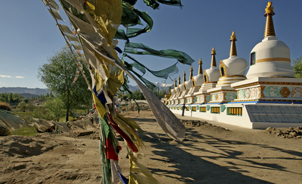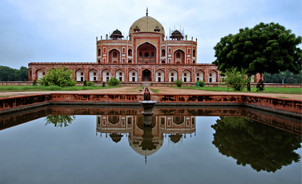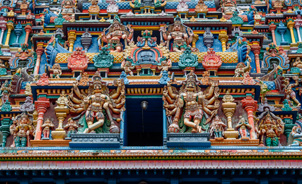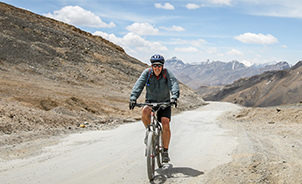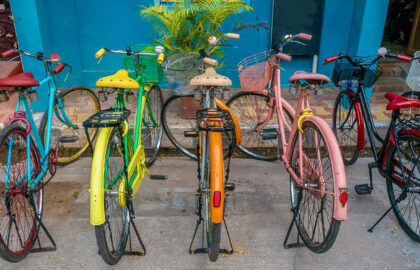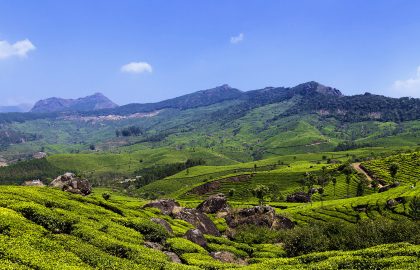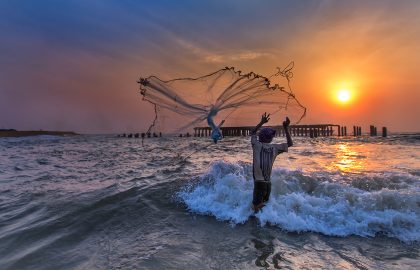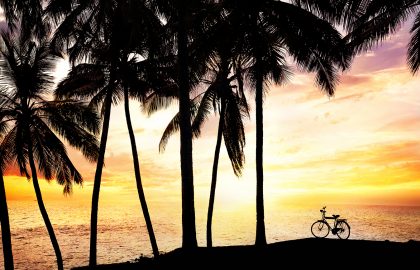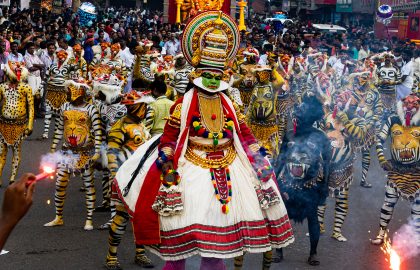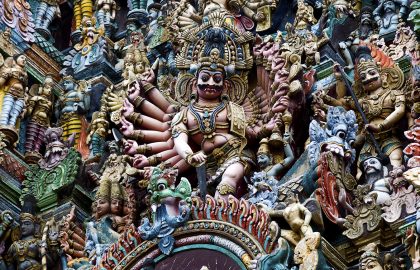From the bustling art hub of Koch to the lush green tea plantations of Munnar, Cycling In India organized an amazing 5-day cycling tour from Munnar to the backwaters of Kerala in Alleppey. During these five days, our group cycled approximately 300 km through sprawling expanses full of tea plantations, high hills of the Western Ghats, thick green canopy-like forests, and the slow yet calm-moving backwaters of God’s Own Country. Kerala – known as “God’s Own Country” has so much to offer. A state that is rich in culture, landscape, environment, and cuisine, we consider ourselves lucky enough to have explored it all on a bicycle.
Day 1: Arrival in Kochi

It was a very warm day in Kochi. We were greeted by the guys from Cycling in India at Kochi International Airport along with the 35C heat and 80% humidity. Our thirst was quenched by the coconut water offered to us. As we exchanged pleasantries, we loaded our bags onto the bus that would take us to Kochi. Once a buzzing hub for sea trade during the Portuguese era, this city is now a bustling cultural capital of South India. We arrived at our hotels in the evening, checked in, and rested up before a lovely dinner by the harbor full of seafood and local Kerala cuisine. After dinner, we were briefed by our cycling guide about the next 5 days of cycling, who showed us our bikes and we even got a test ride around the hotel premises to ensure everything was working smoothly.
Day 2: Exploring Fort Kochi (Drive to Munnar by bus)

Our day of cycling in Kochi started early at around 6 AM to escape the crowds later and have the streets all to ourselves before the traffic sets it. We started by cycling the narrow lanes and spice markets moving towards Mattancherry while marveling at the architecture that resembled colonial Europe. Some houses were built by ancestral British and Portuguese traders of the colonial era. We then rode towards Mattancherry Palace (also known as the Dutch Palace), which is famous for depicting Hindu temple art, portraits, exhibits, and other sculptures of Kerala and Kochi’s religious culture. We parked our bikes safely in a cafe strolled down Jew Town and even had breakfast at the local cafe. We visited the oldest active synagogue in India and the Commonwealth of Nations – the Paradesi Synagogue. We resumed our cycling toward the Santa Cruz Basilica – a basilica that is of gothic style architecture originally built by the Portuguese, destroyed in 1887, and rebuilt as a cathedral in 1558. We had almost finished our exploration of Fort Kochi, but we arrived at the Chinese Fishing Nets, introduced centuries by the Chinese traders. We couldn’t believe our day of cycling was complete by 9 am! As we reached our hotel, we freshened up for a 4-hour long bus tour to the tea hill station of Munnar on the same day. We bid goodbye to the waters of Kochi and were excited to be in the hills of Munnar.
Day 3: Cycling in Munnar

The stark difference in temperature between Kochi and Munnar was something we did not miss. The long and winding roads towards Munnar initially made us carsick, but we got accustomed to the terrain after a while.
Situated at 1,500 metres above sea level, Munnar is a hill station town that consists of the world’s highest tea plantations. It is said that at least 60% percent of India’s tea is cultivated and exported from these surrounding hills. The biggest tea brands in the country employ thousands of workers and cultivators to cultivate the best and most organic tea that is rich with anti-oxidants and a pleasing aroma. One interesting fact about the origin of Munnar – its name originated from its strategic location at the confluence of three rivers – Muthirapuzha, Nallathanni, and Kundala Rivers. What was once a summer retreat for British soldiers due to its low summer temperatures, is now a frequently visited tourist destination in India.
We got on our bikes and cycled the long and winding roads in and around the town of Munnar. We were treated to delightful views of expansive tea plantations, and everywhere we looked – those tea plantations were carved with rough paths marking boundaries between each tea estate. One thing we did not expect was that – it is mandatory to have a tour guide while walking these plantations since tea land is private property and it is not allowed to pass without permission. However, the majority of the tea plantations are owned by the Tata Group which manages the plantations and provides employment to the local community. After our walk, we cycled to the Tea Museum where we learned the history of tea in Munnar, its origins, and its different varieties. After our museum tour, we attended a tea tasting ceremony which awakened our senses and made us feel refreshed. Our day in Munnar was a long but adventurous one. We cycled back to our hotels where we gathered for dinner with some lovely tea for a good night’s sleep.
Day 4: Munnar to Vagamon
Riding out of Munnar has got to be one of the most thrilling and enjoyable rides ever. It was a continuous descent for about 40 km without any bumps, potholes, speed breakers, or even traffic! The areas around Vagamon and Kuttikanam are studded with meadows, pine forests, waterfalls, and tea estates and are often touted as the best hill stations in Kerala. We cycled through a dense forest town called Idukki famous for the rubber factories and tea plantations that surround it. As we continued cycling, we rode past the Idukki reservoir, a massive water body that provides water for cultivating tea in the nearby regions of Munnar. Also famous in Idukki is the Idukki Wildlife Sanctuary which is also a wildlife reserve consisting of the famous Asiatic Elephant and Asian bison or Gaur. We were close to Vagamon, but before that, we had to climb a long and winding road. Our guides gave us the option of sitting in the support vehicle or we could enjoy the uphill challenge. I opted for the uphill challenge. It was the clean and fresh air that made me want to ride up the hilly terrain.
Vagamon is famous for the chain of 3 beautiful hills called Thangal Hill, Murugan Hill, and Kurismala which gives out a secular religious aura and enchanting feel. Although our ride to Vagamon was short, we were allowed to explore the 3 hills with a tour guide for the day. We even relaxed in the famous Vagamon Meadows famous for film shoots because of their beauty. As our day came to an end, we shacked up in a forest homestay surrounded by spice plantations and green forests. We reached Vagamon in the afternoon, tired yet refreshingly alive due to the clean air. We checked into our homestays situated in the thick green forests of Vagamon.
Day 5: Vagamon to Kumarakom
On day 5 of our cycling adventure in Kerala, we were excited for another thrilling ride down to the flat region of Kerala from Vagamon. The entire route was downhill. Since some of us were quite exhausted from the day before, we were excited to explore the region without any pedaling. We began our ride at 8 AM from our homestay amidst cool morning temperatures that were aided by the forests around us.

In what would be the best 20 km descent I have ever had, I was lucky enough not to face any traffic or bad roads. The long and winding road from Vagamon led us downhill for 20 km to the small town of Erattupetta – which is a trading centre for spices, rubber, areca nut, and other agricultural products. After Erattupetta, we cycled a further 12 km to reach Pala, a small Christian town known for the St Thomas Church. The St.Thomas Church known as ‘Pala Pally’ was built on the banks of the Meenachil River in the year AD 1002, later elevated to ‘Valiapally’ and then Cathedral. Ancient and famous catholic families – Tharayil, Erakonni, Vayalakkombu & Koottunkal together put their efforts to fulfill the construction of the church. When years rolled out the influx of the faithful also increased. So, in the 18th century, the ‘Pazhaya Pally’ (the old church now) had been constructed.
After Pala, we cycled through Kerala’s heart full of paddy fields, palm groves, and local villages filled with people going about their crafts of sorting out grains and vegetables. We cycled along the Meenachil River which was filled with local fisherman out with their nets on the hunt for the catch of the day. As we reached Kumarakom, we were amazed by the intriguing network of canals and waterways. The longest lake in India and the largest lake in Kerala, Vembanad Lake borders three major districts in Kerala and is home to many boathouses, festivals, bird sanctuaries, and even annual boat races. In Kumarakom, we were treated to a canoe ride in one of the canal networks which made us feel like we were in Venice, except without the brick buildings around us. On this boat ride, we also got to learn about the people who reside here and their daily lives involving fishing, their customs, and lifestyles. Our time in Kumarakom culminated with a lovely evening on a houseboat with some delicious Kerala seafood.
Day 6: Kumarakom to Alleppey

Our ride from Kumarakom to Alleppey involved a short ferry ride across the lake. But before that, we took a short detour to the city of Kottayam. It is renowned for its ancient European architecture and Syrian Christian Churches which were built in the late 1500s. As we entered this historical city, it was quite evident in the buildings that this was a place of literature and education. Kottayam is also called “the City of Letters”, as many of the first Malayalam daily newspapers and publishing houses were started and are headquartered here.
After our detour to Kottayam, we reached Kumarakom by bike. We were amazed by the intriguing network of canals and waterways. We got to witness the longest lake in Kerala – Vembanad Lake, which is home to Kerala’s countless houseboats. On the boat, we cruised through the backwaters of Alleppey, we rowed up close to quaint villages, rice paddy fields, churches, and old houses. Our boat ride took us to the nearby towns of Kuppapuram, Kainakry, Chennamkary, Nedumudy, and Pulinkunnu. These towns are known for some of the most nutritious and delicious seafood found in these waters We then cycled further inland and visited the famous Chavara Church where a famous beacon light 250 years old is still well preserved.
Day 7: Alleppey to Kochi

It was our last day in Kerala and we weren’t ready to say goodbye to this beautiful state. Having seen it on the bicycle, I’m sure it would’ve been exponentially better than having seen it from a vehicle. We got to witness the local culture, meet the people, and taste the local cuisine.
Our last ride on this tour of Kerala involved a slow ride from Alleppey to Fort Kochi on relatively flat terrain and a beautiful coastal highway for approximately 50 kilometres. We reached Fort Kochi in the afternoon checked in to our hotels and freshened up for a light evening of fun at the hotel organized by Cycling in India.
The following morning, we checked out of our hotel and headed towards the airport in our pick-up transport taken care of by the hotel and our tour guides.
As we departed Kochi, we saw the crisp coastline and the serene backwaters from our windows reminiscing about our amazing cycling tour across God’s Own Country.

